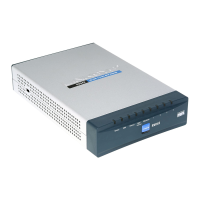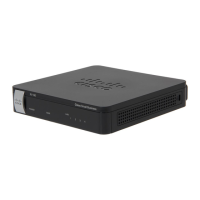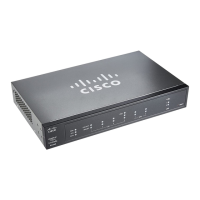Chapter 4
Advanced Configuration
26
10/100 16-Port VPN Router
Retry Timeout Enter the number of times the Router will
try to make a connection to your ISP before it times out.
When Fail Should the connection be lost, set the Router
to perform one of the following actions, Remove the
Connection or Generate the Error Condition in the
System Log.
Remove the Connection • Failover will occur; the
backup will be used. When the WAN port’s connectivity
is restored, its traffic will also be restored.
Generate the Error Condition in the System •
Log Failover will not occur; only an error condition
will be logged.
Default Gateway Select this option to ping the Default
Gateway.
ISP Host Select this option to ping the ISP Host. Then
enter the IP address.
Remote Host Select this option to ping the Remote Host.
Then enter the IP address.
DNS Lookup Host Select this option to ping the DNS
Lookup Host. Then enter the IP address.
IP Group
The IP Group settings allow you to specify the IP Group,
as well as the Service or Destination IP going through the
selected WAN port.
These settings are not available for WAN1, which always
uses Intelligent Balancer (Auto Mode).
Service Select the Service you want.
If the Service you need is not listed in the menu, click
Service Management to add the new service. The Service
Management screen appears.
Service Management
Service Name Enter a name. For IP Binding only, select
All.
Protocol Select the protocol it uses.
Port Range Enter its range.
Click Add to List. Click Save Settings to save your changes,
or click Cancel Changes to undo them. Click Exit to return
to the Multi-WAN screen.
If you want to modify a service you have created, select it
and click Update this service. Make changes. Click Save
Settings to save your changes, or click Cancel Changes to
undo them. Click Exit to return to the Multi-WAN screen.
If you want to delete a service you have created, select it
and click Delete selected service. Click Save Settings
to save your changes, or click Cancel Changes to undo
them. Click Exit to return to the Multi-WAN screen.
Source IP Enter the source IP address or range. If you only
need to specify the Service, then keep the default, which
is 0 to 0.
Destination IP Enter the destination IP address or range.
If you only need to specify the Service, then keep the
default, which is a series of zeroes.
Enable Select Enable to use this Protocol Binding rule.
Click Add to List, and configure as many rules as you
would like, up to a maximum of 100. To delete a rule, select
it and click Delete selected application.
Click Save Settings to save your changes, or click Cancel
Changes to undo them.
On the Edit Load Balance screen, click Save Settings to
save your changes, or click Cancel Changes to undo them.
Click Back to return to the Multi-WAN screen without
saving any changes.
System Management > Bandwidth
Management
Quality of Service (QoS) features let you control how
the Router manages network traffic. With Bandwidth
Management (Layer 3), the Router can provide better
service to selected types of network traffic. There are two
types of functionality available, and only one type can
work at one time. Rate Control functionality is for minimum
(guaranteed) bandwidth and maximum bandwidth by
service or IP address, while Priority functionality is for
services. Both types can control inbound or outbound
traffic.

